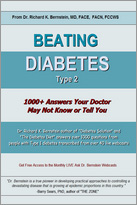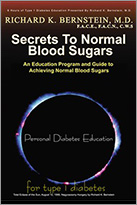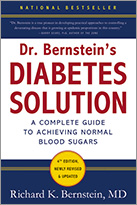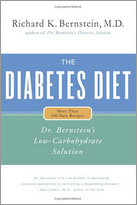Mark Wade, M.D., is one of many physicians with diabetes. He is board certified in pediatric medicine. His lovely wife not long ago gave birth to their third child. His story has a number of parallels with my own.
“Dr. Bernstein’s program turned my life around. Prior to meeting Dick Bernstein at age thirty-four, I had spent twenty-two years of my life as what I then considered a well-controlled insulin-dependent, juvenile-onset diabetic. I’d never been hospitalized for ketoacidosis [a serious condition caused by high blood sugar in combination with dehydration] or hypoglycemia [low blood sugar], had what I considered good circulation and nerve function, exercised daily, and ate pretty much whatever I felt like eating.
“However, cuts and lacerations took months or years to heal instead of days, and always left ugly scars. Once or twice each year, I would develop pneumonia that typically lasted four months and had me, without fail, out of school or work for two and a half months per episode. My mood swings went from kind and lovable to short-tempered, hotheaded, and uncaring four to five times daily, congruent with my routine blood sugar swings from high blood sugars (300 to 500) after meals to hypoglycemia (less than 50) before meals. This Dr. Jekyll/Mr. Hyde personality made me very unpredictable and unpleasant to be around, and came close to causing me to lose my wife and the closeness of family and friends. I was forced to eat my meals at exactly the same times each day in order to avoid life-threatening episodes of low blood sugar. Even so, I had to adjust my life around the inevitable periods of hypoglycemia. If I didn’t eat, my life was in trouble, and unfortunately so were the people who had to interact with me when I was hypoglycemic. Most of the times those were the ones I loved most.
“My training as a physician, as an intern and resident, averaging 110 hours a week of work, was at times a nightmare, though I did it, trying to balance rounds, clinics, emergency room and ICU schedules, screening patients, long hours of reading, and an unreal demand on physical tolerance, emotional stability, and consistency that almost drove me to the breaking point. My mission was to be an excellent doctor, and I was, with a calm, cool demeanor which I presented externally, but inside I was a mess, and my interactions with my loved ones and close friends were horrible. I was an avid basketball player, jogger, and weight lifter, but despite doing these activities daily, I found my performance and endurance were usually modulated by my blood sugar—and was never really sure whether I would be able to perform for 10 minutes or 2 hours. In addition, despite my high level of exercise, 1 to 1 1/2 hours daily for twelve years, I was never able to develop a muscular or athletic body type, even though I worked hard at it.
“I was never a ‘brittle’ diabetic. I was always extremely conscientious about testing and exercising and eating and doctor visits, to the point that my friends thought I was neurotic. I was consistently following the conventional guidelines recommended to diabetics, and I thought I was a rather model patient. The problems that I described above, I had been led to believe, were a natural part of life for a diabetic. No one showed me that my life could be better, that I could control my diabetes rather than let my diabetes control me, that with recognition of a few principles that are really just common sense, a few extra finger sticks and a few extra injections and better control of my dietary intake—I could be in charge for real!
“Nine years ago, I met Dick Bernstein. Dr. Bernstein not only gave me the most complete, comprehensive, logical, reasonable, and informative teaching on diabetes that I have ever encountered, but his uniquely expert and comprehensive physical examination and testing illuminated for me the most accurate picture of my overall health and the subtle tolls that the previous management of my diabetes had permitted. Then with a personalized, comprehensive, tightly controlled but reasonable diet, exercise, and a blood sugar–monitoring plan, he put me in control of my diabetes for the first time. Sure, the diet plan, finger sticks, and 5 to 8 insulin injections a day for my program require a high degree of discipline and self-control, but it’s doable, it works, and this comparatively small sacrifice brings me the freedom of lifestyle, quality of life, and longevity that nondiabetics take for granted.
“The results have been as follows: I can eat or fast whenever I choose. I plan my day around my activities rather than around my meals, have the ability to be much more flexible in my schedule and participation in activities, and now have the ability to adjust my daily activities easily to accommodate ’emergencies’ or sudden changes in schedule—activities and adjustments that nondiabetics take for granted. Best of all, the wild mood swings have been eliminated and I’m sick much less often and less seriously.”




